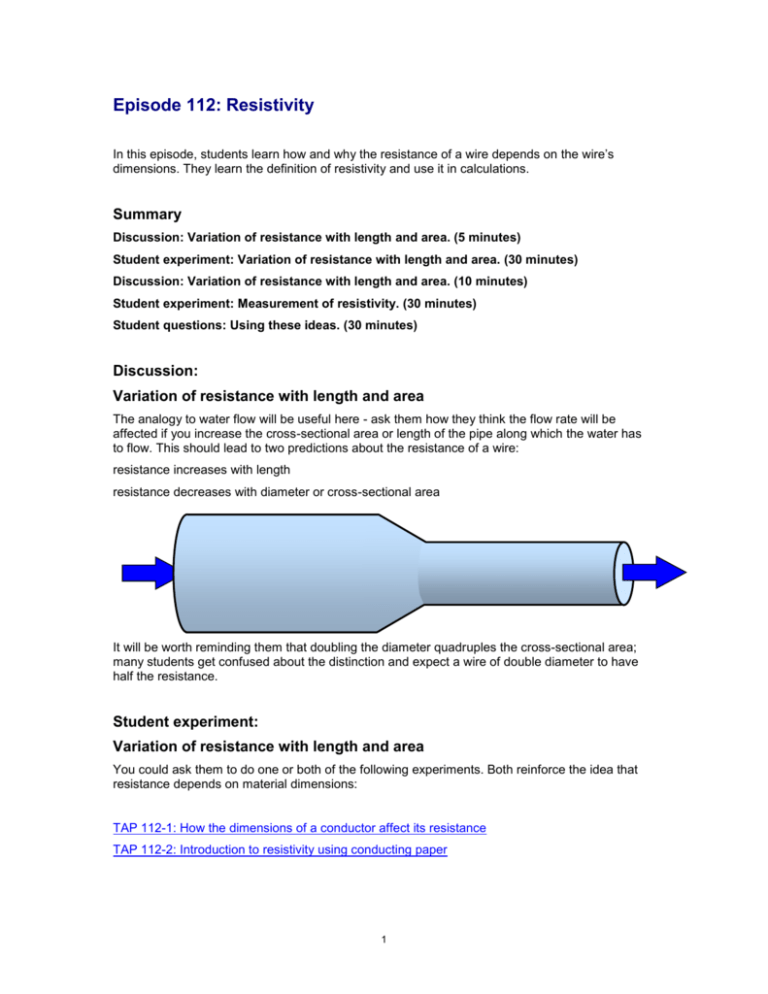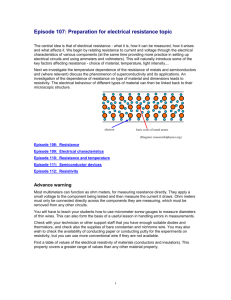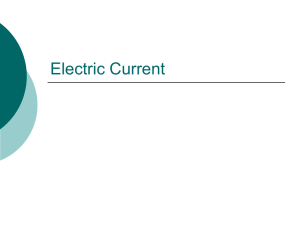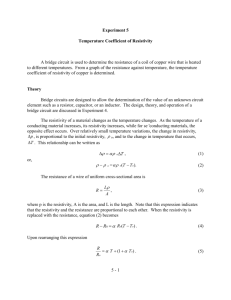Episode 112: Resistivity (Word, 116 KB)
advertisement

Episode 112: Resistivity In this episode, students learn how and why the resistance of a wire depends on the wire’s dimensions. They learn the definition of resistivity and use it in calculations. Summary Discussion: Variation of resistance with length and area. (5 minutes) Student experiment: Variation of resistance with length and area. (30 minutes) Discussion: Variation of resistance with length and area. (10 minutes) Student experiment: Measurement of resistivity. (30 minutes) Student questions: Using these ideas. (30 minutes) Discussion: Variation of resistance with length and area The analogy to water flow will be useful here - ask them how they think the flow rate will be affected if you increase the cross-sectional area or length of the pipe along which the water has to flow. This should lead to two predictions about the resistance of a wire: resistance increases with length resistance decreases with diameter or cross-sectional area It will be worth reminding them that doubling the diameter quadruples the cross-sectional area; many students get confused about the distinction and expect a wire of double diameter to have half the resistance. Student experiment: Variation of resistance with length and area You could ask them to do one or both of the following experiments. Both reinforce the idea that resistance depends on material dimensions: TAP 112-1: How the dimensions of a conductor affect its resistance TAP 112-2: Introduction to resistivity using conducting paper 1 Discussion: Variation of resistance with length and area Follow up with some theory suggesting: Resistance is proportional to length l Resistance is inversely proportional to cross-sectional area A R= constant x length / cross-section area The constant is a property of the material used - its resistivity R = l / A The units of resistivity can be derived from the equation: m. Emphasise that this is ‘ohm metre’, not ‘ohm per metre’. Discuss the great range of resistivities amongst materials. Values for metals are very small. The resistivity of a material is numerically equal to the resistance between opposite faces of a onemetre-cube of the material; although this is not a good definition of resistivity, imagining such a block of metal does indicate why its value should be so low (~10 -9 m). Student experiment: Measurement of resistivity Complete this section by asking your students to measure the resistivity of several metal wires. This experiment provides an opportunity for a detailed discussion of the treatment of experimental errors. TAP 112-3: Measuring electrical resistivity Student questions: Using these ideas Problems involving resistivity. Students often get confused between cross-section area and diameter. Make sure they are able to convert mm2 to m2 for resistivity calculations. TAP 112-4: Electrical Properties 2 TAP 112- 1: How the dimensions of a conductor affect its resistance In this experiment you will study how the size and shape of a conductor affect its resistance, even though the material from which the conductor is made does not change. Requirements about 50 g of conducting putty pair of putty contacts 2 digital multimeters 5 4 mm leads power supply, 0–12 V dc cutting board for the putty (on which it can rest during the experiment) table knife disposable plastic gloves (Warning: the putty is not toxic but it stains hands and clothing.) Steps to follow Handle the putty for a moment or two. How would you describe its mechanical properties? You can easily mould the material and this makes it suitable for an experiment in which you change the shape of a substance and observe how these changes affect the resistance. You need to carry out two separate experiments. In the first, try to answer the question: how does the resistance of the putty vary with length when the cross-sectional area remains constant? In the second, keep the length constant, alter the area and see how the resistance changes. Make sure that you have a good contact between the putty and the connectors. When you are manipulating the putty, try to avoid creating voids (hollows) inside. Also, avoid raising the temperature of the material – this needs to stay constant too. There are two ways in which you could inadvertently warm the putty up; what do you think these are? 3 A V conducting putty conducting putty To investigate the dependence on length: 1. Roll the putty on the board into a cylinder with a uniform diameter of approximately 2 cm and a length of about 10 cm. Apply a pd of about 2 V along the length of the material, then measure and record the current. Reduce the length and repeat these measurements. If you manage to adjust the pd so as to keep the current constant then the pd will be a measure of the resistance – can you explain why this is? To investigate the dependence on area: 2. Roll the putty into another 10 cm long cylinder and cut it into two 5 cm lengths. Measure the resistance of one of these. Mould the putty along the lengths into a new cylinder still 5 cm long but with twice the area. What happens to the resistance? Confirm this result with other cross-sectional areas. It is helpful to use a theoretical model to help you make sense of your result. 3. Imagine two identical resistors: identical in all respects, size, material and resistance. What is the combined resistance if they were connected end-to-end? What is the combined resistance if they are connected side-by-side parallel to the long axis? Introducing resistivity 1. You will come up with a clear pattern relating length to resistance. 2. You will come up with a clear pattern relating cross-section area to resistance. 3. You may also realise that you need to include a constant of proportionality to write these rules down as a single equation. This constant is known as the electrical resistivity. 4 Practical advice This experiment is one of a pair providing alternative introductions to resistivity. You might like to use different alternatives with different parts of the class and then get them to report back. This is a good place to show simple experimentally derived patterns building up into a concise mathematical summary of those results. In this experiment students can show that the resistance is directly proportional to the length (double one, double the other) whereas if the cross-section area doubles the resistance halves. Suitable contacts: each contact should be a disc of brass roughly 2 cm in diameter with a tube of brass brazed to the centre of one face at 90° to the surface. The internal diameter of the brass tube should be such as to accept the standard lead plug in use in the laboratory (i.e. 4.1 mm). The analysis carried out by the students can be made slightly more complicated by keeping the pd across the material constant and then measuring the current. In this case the students either plot a graph of resistance against reciprocal length (a straight line) or evaluate the product of resistance and length (a constant). Trials yielded values of about 100 mA with pds of about 1.5 V. If using discrete meters the following are likely to be suitable: voltmeter dc fsd 5 V, ammeter dc fsd 1 A. External references This activity is taken from Advancing Physics Chapter 4 340E 5 TAP 112- 2: Introduction to resistivity using conducting paper How the dimensions of a conductor affect its resistance In this experiment you will use conducting paper to find out how the size and shape of a material affect its resistance, even though the material from which the conductor is made does not change. Such information and knowledge are vital to a designer who wishes to predict the behaviour of a component in a circuit. You will need graphite film on paper colloidal graphite to connect the paper to the optical pins hairdryer power supply, 0–12 V dc 5 4 mm leads two optical pins two bulldog clips, each with a lead soldered to the 'handle' What to do In this experiment you cut out the shape of the conductor you wish to use, then make electrical connections to it and measure the resistance. 1. You need to carry out two separate experiments. In the first, try to answer the question: how does the resistance of the paper vary with length when the cross-section area remains constant? In the second, keep the length constant, alter the area and again see how the resistance is affected. Remember that the conducting layer has a uniform thickness. bulldog clip optical pin graphite paper sample connections to circuit Make the connections to the paper by clamping an optical pin to it with bulldog clips. Now run a layer of liquid graphite between pin and paper to ensure a good contact. You will probably need to use a hairdryer to dry the contacts before use. 6 A V paper sample 2. Apply a pd of about 4 V across along the length of the film, then measure and record the current. Reduce the length and adjust the pd in order to keep the current the same as before. Repeat for other lengths. The current is fixed, and therefore the applied pd is a measure of the resistance. 3. Is there a simple rule connecting the various quantities? In an experiment such as this, it is a good idea to start with one variable and then double it, and then double it again – so that it is now four times the original value – and so on. In this way you can often see patterns straight away. If, for example, the original variable had gone up four times but the quantity you were measuring had only doubled, what would the relationship be? 4. It is helpful to use a theoretical model to understand the physics of your result. Imagine two identical resistors – identical in all respects, size and resistance. What would the combined resistance be if they were connected end-to-end? What would the combined resistance be if they were connected side-by-side parallel to the long axis? When you have spotted the pattern experimentally and in your theoretical model, you might like to go back and check any anomalous results. 5. Try to write the relationship down as an equation. Introducing resistivity 1. You will come up with a clear pattern relating length to resistance. 2. You will come up with a clear pattern relating area to resistance. 3. You may also realise that you need to include a constant of proportionality to write these rules down as a single equation. This constant is known as the electrical resistivity. Practical advice This experiment is one of a pair providing alternative introductions to resistivity. You might like to use different alternatives with different parts of the class and then get them to report back. This is a good place to show simple experimentally derived patterns building up into a concise mathematical summary of those results. You may need to emphasise the point that the film thickness is constant and so the cross-sectional area is proportional to the width. In this experiment students can show that the resistance is directly proportional to the length (double one, double the other) whereas if the area doubles the resistance halves. Connecting the paper to the circuit- there are a number of possibilities other than that quoted in the worksheet. Aluminium foil can also be used as an interface, but again the students need to use a dried graphite interface. Students need to ensure good contacts whichever method they use. The 7 analysis can be made slightly more complicated by keeping the pd constant across the material and then measuring the current. In this case the students either plot a graph of resistance against reciprocal length (a straight line) or calculate the product of resistance and length (a constant). Alternative approaches The films can be created with conducting colloidal graphite (Aquadag) or graphite pencil on graph paper. No matter which graphite you are supplied with, the basic method is the same. You paint (or draw) the shape of the conductor onto graph paper (the squares help to get the shape and size correct) in as even a layer as possible. Try to apply the graphite consistently when you make further test shapes. When the paint is dry (you may need to use the hairdryer), make electrical connections to it and measure the resistance. External references This activity is taken from Advancing Physics Chapter 4, 360E 8 TAP 112- 3: Measuring electrical resistivity A fundamental material property You have now learnt how the shape of a material (length and cross-section area) controls its resistance. You also know the definition of resistivity. In this experiment you will measure the resistivity of a sample of metal wire. Once you know the resistivity of a conductor and its dimensions you will always be able to predict its resistance. Requirements constantan wire of diameter 0.27 mm and 0.56 mm power supply, 0–12 V dc and ac, 6 A 2 digital multimeters micrometer screw gauge 4 mm leads a clip component holder for optional extension: nichrome; iron wire; copper wire each in the same gauge as the constantan What you need to do 1. Set up a circuit to measure the resistance of one of your wires. 2. Estimate roughly what current is likely (you may wish to know that one metre of the thicker constantan has a resistance of the order of 2 Ω, the thinner wire about 8 Ω) and choose values of pd accordingly in order to protect your meters. You should also choose a small current so that the wire does not get hot. Such a temperature change will alter the resistivity value. Check the values with your teacher if you are unsure. 3. Measure the length of your wire and check the diameters using the micrometer screw gauge (the quoted diameters in the requirements are only nominal figures). Repeat each of these measurements several times; take the diameter at several points along the wire. Average the results. 4. Calculate the resistivity using the formula, R = l / A 5. Repeat steps 1–4 for the other constantan wire. 6. How similar are the values you have obtained? 7. Optional extension: Now try measuring the resistivity of nichrome. This is the material used for the element of an electric fire. As a guide to currents, 0.27 mm nichrome has a resistance per unit length of about 10 ohm per metre. The figure for 0.56 mm nichrome is 2.5 ohm per metre. 8. Optional extension: measure the resistivity of copper and iron and try to estimate the resistance of a single strand of these materials about the size of a human hair. This experiment is not easy as these wires have much lower resistances than the constantan and nichrome. 9 Understanding resistivity 1. You can calculate and use resistivity values. 2. You can use units for resistance per unit length and resistivity correctly. Practical advice Typical values for resistance per unit length Iron: 0.56 mm, 0.5 m–1; 0.27 mm, 2 m–1 Copper: 0.56 mm, 0.07 m–1; 0.27 mm, 0.3 m–1 To measure these resistivities with the meters available, most students will choose to use long lengths so (to avoid waste) it might be best to have one or two pre-prepared long lengths already wound onto card or a bobbin. Measuring the diameter is something of a challenge and a variety of techniques might be suggested, of which the micrometer screw gauge is only one. Students may well suggest using a microscope, mass of a long length, volume of a long length. The point here is that the micrometer (which they have probably already met) is not the only possible device. External references This activity is taken from Advancing Physics Chapter 4, 350E 10 TAP 112- 4: Electrical properties Questions for practice These questions are provided so that you can become more familiar with quantities describing electrical properties of materials and so that you can become better at doing calculations with these quantities. Try these 1. What length of an alloy wire of resistivity 5.0 10-7 m and diameter 0.50 mm is required to make a standard 6.0 resistor? 2. The heating element of a hairdryer is made of coiled nichrome wire. The diameter of the wire is 0.46 mm and the length of the wire is 7.3 m. Calculate the resistance of the element at 0 °C. The resistivity of nichrome is 110 10-8 m. 3. The copper track on a printed circuit board is made from copper foil 35 m thick. The width of the track is 0.16 cm and the resistivity of copper is 1.69 10-8 m. What is the resistance of 1 cm of track? Pure unstressed platinum wire is the preferred material for making a precision temperature sensor. A standard in common use says that a sensor must have a resistance of 100 at 0 °C. The resistivity of platinum is 9.81 10 -8 m at 0 °C. The wire to be used has a diameter of 0.050 mm. 4. How long should the wire be? 5. What is the volume of the platinum in the wire? The density of platinum is 21.45 103 kg m-3 and platinum is about £10 000 kg-1. 6. Find the cost of the amount of platinum used in the sensor. Detectors can also be made by printing a fine track of platinum on to a ceramic substrate. The element must have a resistance of 100 . The track is 4.0 10-4 cm wide and 81 cm long. 7. How thick will the film of platinum need to be? 8. Estimate the cost of the platinum used in this sensor. 11 Answers to electrical properties 1. 2.4 m 2. 48 3. 3.0 × 10–3 4. 2.0 m. 5. 3.9 × 10–9 m3 6. 84 p 7. 0.20 mm 8. 14 p External references This activity is taken from Advancing Physics Chapter 4, 70S 12








